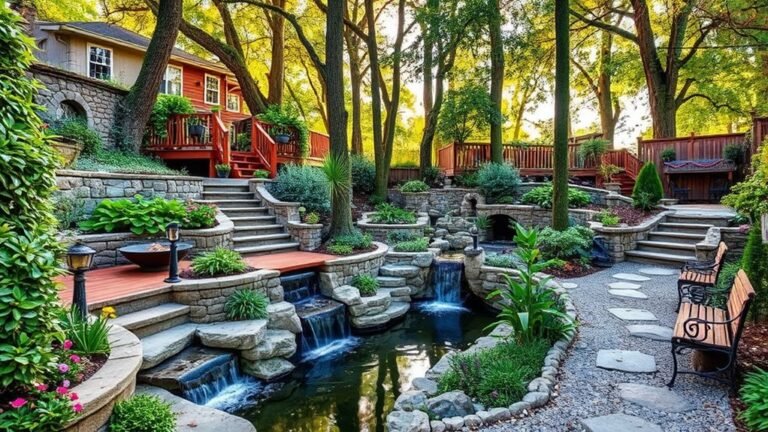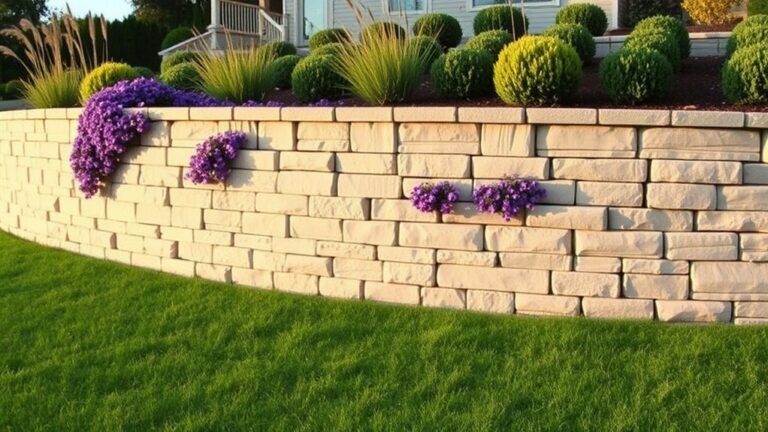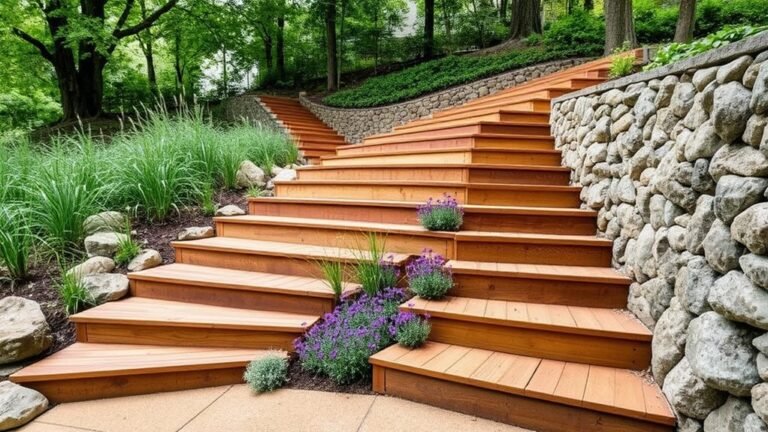13 Wood Retaining Wall Ideas for Sloped Backyards
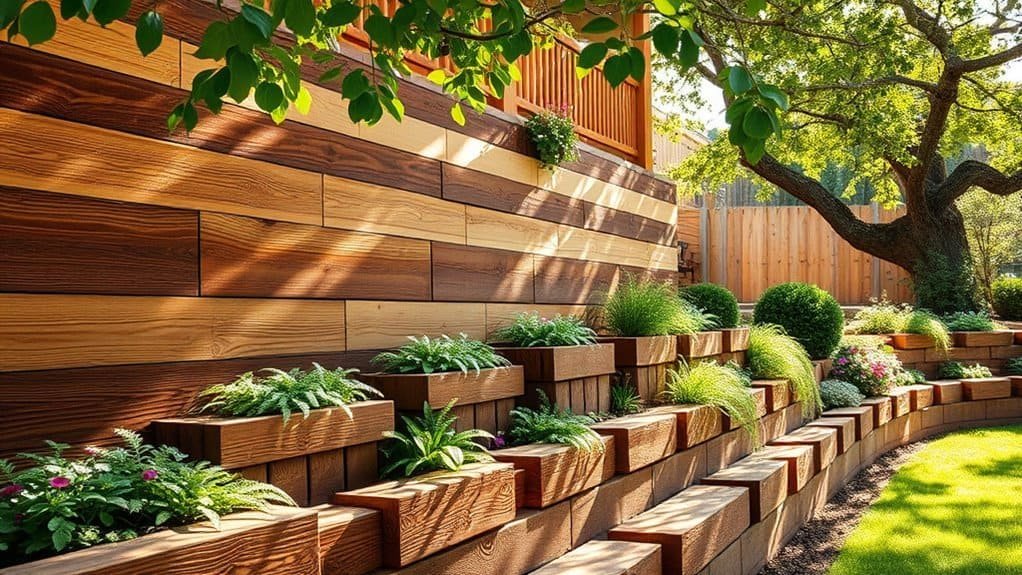
Enhancing your sloped backyard with wood retaining walls offers both style and functionality. Consider contemporary vertical slat designs, tiered planter boxes for greenery, or curved walls to soften the landscape.
Reclaimed wood can add character, with each design choice presenting its own benefits and challenges. Explore these ideas to discover creative solutions that fit your vision.
Vertical Slat Design
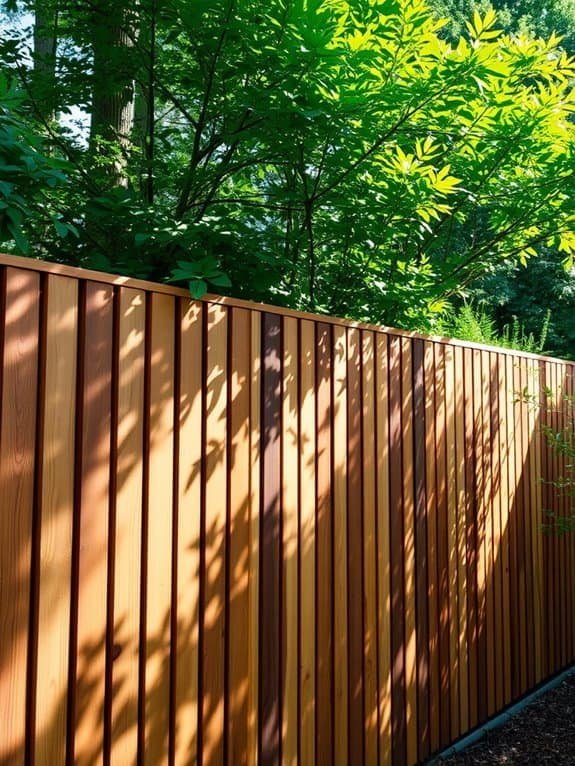
A vertical slat design can elevate your sloped backyard into a stylish and functional area. Picture rows of sleek wooden slats creating a chic barrier that adds depth and character, with vertical lines drawing the eye upward to enhance the space and provide a trendy vibe.
This design allows for a variety of wood types and finishes, from rustic to modern painted slats. These walls can also serve as a support for climbing plants, making your garden feel lush and vibrant with flowers or vines wrapping around the slats. Additionally, incorporating decorative lighting can highlight your vertical slat design, adding ambiance and safety to your outdoor space.
Installation is straightforward—requiring only basic tools and planning. Gather your materials, unleash your creativity, and let your sloped backyard shine!
Who knew retaining walls could be so exciting?
Tiered Planter Boxes
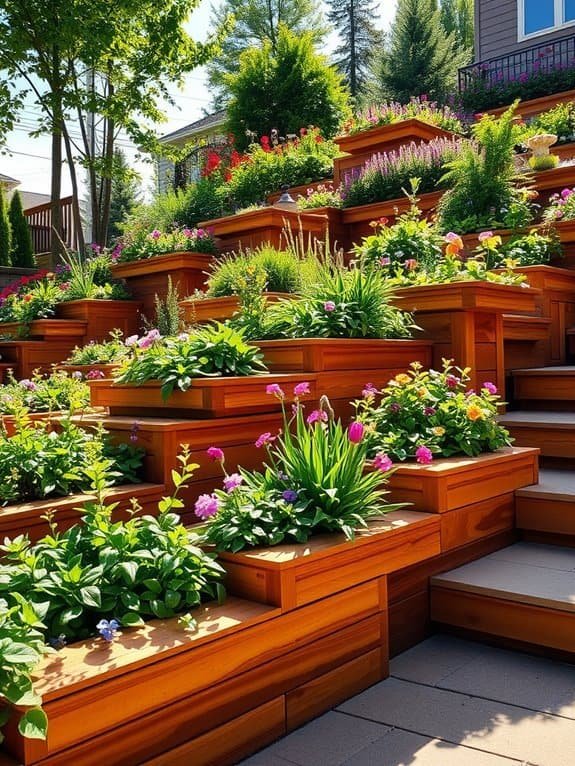
Tiered planter boxes enhance the aesthetics and functionality of sloped backyards, creating a stunning visual effect that transforms your space into a lush retreat.
Perfect for planting colorful flowers and herbs, these structures allow you to indulge your gardening passion and can even impress your neighbors. They effectively maximize space while minimizing erosion on your slope.
You can customize the size and style to suit your backyard's vibe—use reclaimed wood for a rustic look or treated lumber for a sleek finish.
Building them is easy; simply stack and secure in place.
Add whimsy by incorporating fairy lights or decorative stones to make the planter boxes stand out.
With a dash of creativity, you can create a charming garden oasis that's both functional and visually appealing!
Curved Retaining Wall
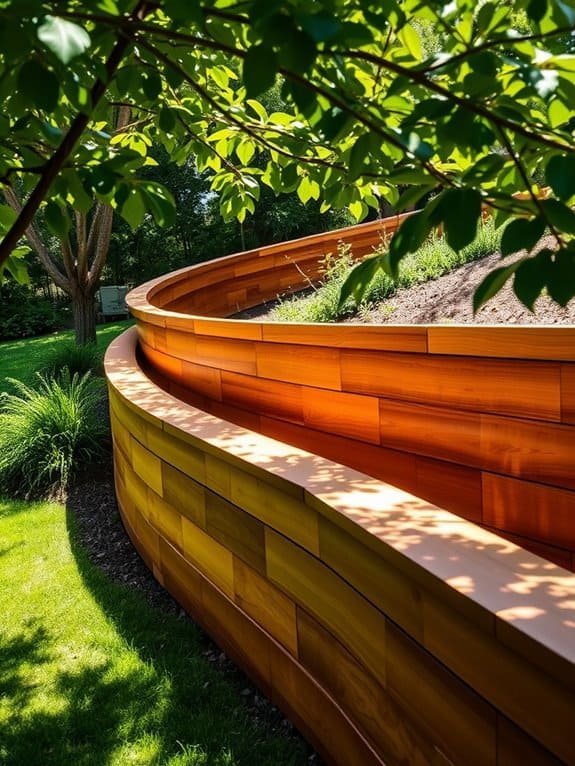
Why choose a straight line when a curved retaining wall can enhance your sloped backyard?
Curved designs not only soften sharp angles in landscaping but also create a natural flow that aligns beautifully with your yard's contours.
Consider these three benefits of a curved retaining wall:
- Aesthetic Appeal: Curves make your yard more inviting by drawing the eye and reducing rigidity.
- Functionality: Curved walls stabilize soil and manage water drainage, promoting a thriving garden.
- Unique Planting Areas: The curves create opportunities for vibrant flowers and greenery that can spill over the wall.
Reclaimed Wood Structure
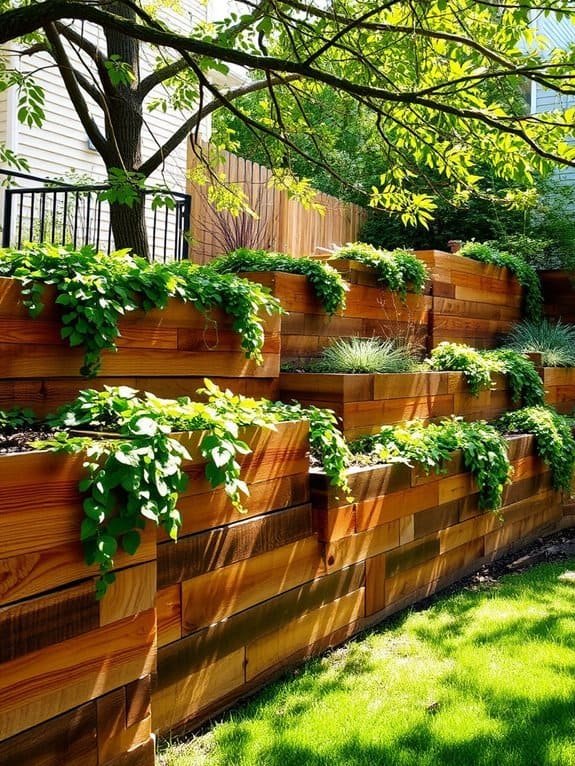
Curved retaining walls create an impressive backdrop for landscaping, and using reclaimed wood is a standout option.
Transform your sloped backyard into a cozy retreat with this unique material that carries history and character. Reclaimed wood not only adds visual appeal but also boasts durability, having weathered the elements and developed natural rot resistance—ideal for outdoor projects.
Mixing different types of reclaimed wood can enhance the texture and visual interest of your wall.
When planning, consider how the wall complements your existing landscape; incorporating plants or decorative stones can enhance its beauty.
Remember, a reclaimed wood wall isn't just functional but also a work of art.
Get ready to make your backyard the talk of the neighborhood!
Lattice-Backed Walls
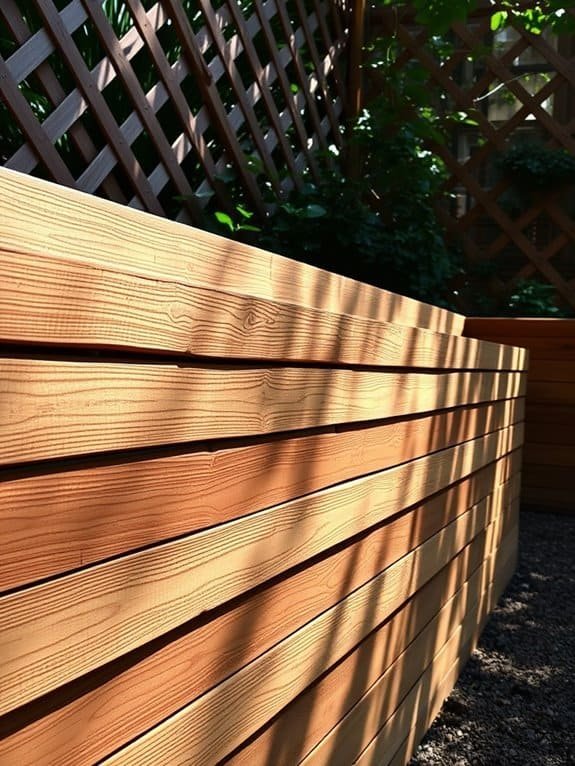
Considering adding height and structure to your sloped backyard? Lattice-backed walls offer a functional yet aesthetically pleasing solution. They not only provide support but also create an inviting backdrop for your garden.
Here are three reasons to choose lattice-backed walls:
- Vertical Space Utilization: Maximize vertical space to make your garden feel larger, and train climbing plants to enhance greenery.
- Enhanced Privacy: The lattice design offers privacy while maintaining an open feel, creating a cozy spot for enjoying your morning coffee away from prying eyes.
- Aesthetic Versatility: Customize the walls in various styles—paint to match your home or keep them natural for a rustic look. The possibilities are endless!
Rustic Log Retaining Wall
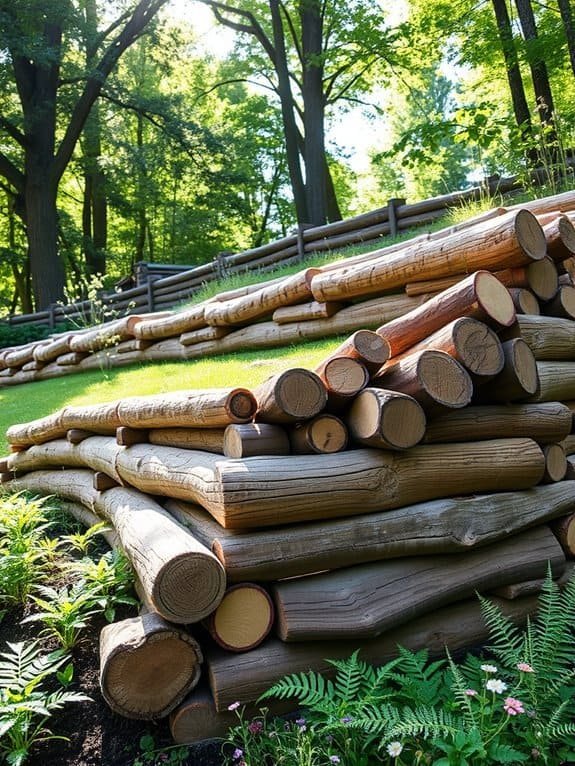
If you're seeking a natural way to reinforce a sloped backyard, a rustic log retaining wall could be ideal.
Picture sturdy logs stacked to form a warm barrier that enhances your landscape while holding soil in place.
Building a rustic log wall is easier than you might think. You can use whole logs or cut them into shorter sections, just ensure to select durable woods like cedar or redwood for longevity.
Leaving some bark on the logs adds to the natural charm.
Drainage is crucial; make sure to leave space between the logs for water escape to avoid sogginess.
You can also plant flowers or shrubs in front for added color.
Create a stunning rustic log retaining wall—making your backyard the envy of the neighborhood!
Modern Timber Sleeper
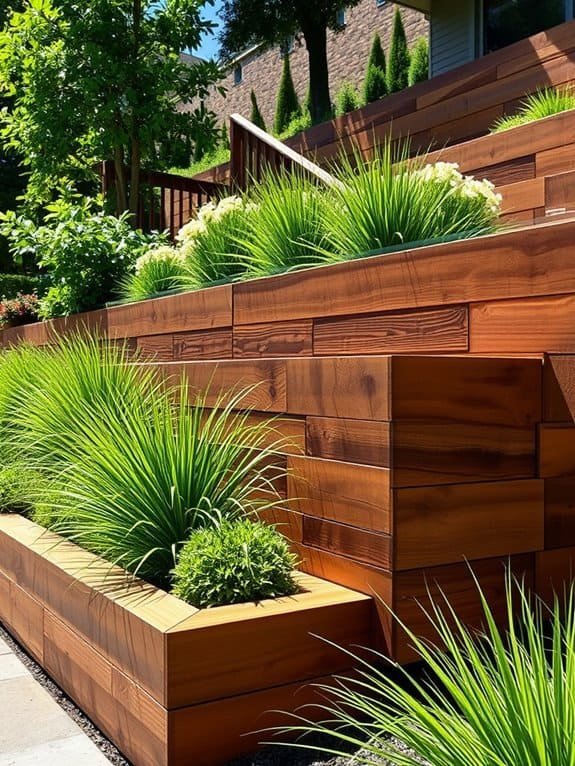
For a sleek and contemporary look in your sloped backyard, consider a modern timber sleeper retaining wall. These walls provide stability while adding elegance to your space and are surprisingly versatile!
Here are three reasons to love modern timber sleepers:
- Stylish Aesthetics: Their clean lines and minimalist design create a fresh vibe, complementing various landscaping styles and impressing your neighbors.
- Durability: Treated timber sleepers withstand rain, sun, and snow, ensuring your wall remains strong and free from rot.
- Eco-Friendly Options: Many timber sleepers come from sustainable forests, allowing you to enhance your backyard while making an environmentally conscious choice.
A modern timber sleeper retaining wall not only addresses sloping issues but also beautifies your outdoor space.
Integrated Seating Areas
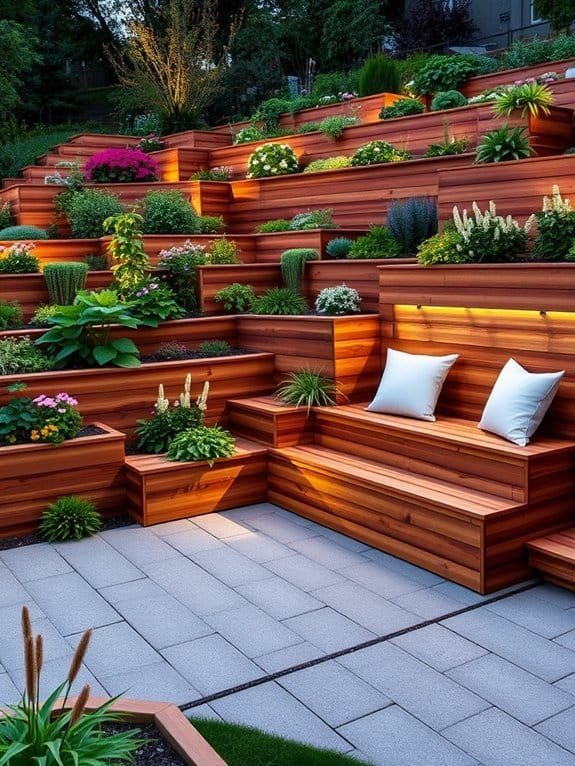
Modern timber sleeper retaining walls enhance your sloped backyard by providing integrated seating areas. Imagine transforming these sturdy walls into cozy nooks where you can unwind while enjoying the view. Build benches into the walls to maximize space and add charm. Visualize sipping coffee on a sunny morning surrounded by lush greenery or hosting friends for a barbecue. Enhance comfort with cushions or throw pillows, and consider incorporating small tables for snacks and drinks, creating a mini outdoor living room. With timber's natural warmth, your seating will seamlessly blend with the landscape, offering a front-row seat to nature's beauty. You can also add twinkling lights to the area to enhance ambiance and create a magical atmosphere during evening gatherings. Say goodbye to dull backyards and embrace a stylish, multi-functional space that encourages relaxation and fun. Your sloped backyard will appreciate it!
Decorative Post and Beam
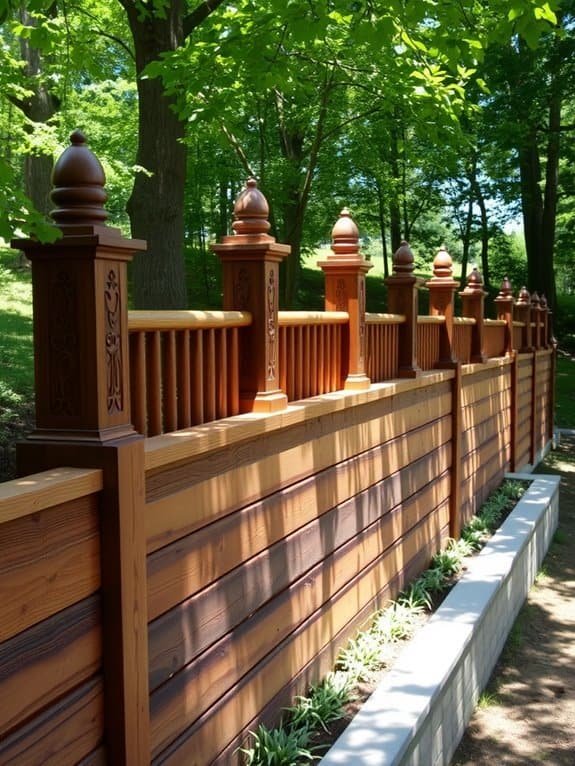
While retaining walls are often seen as functional, adding decorative post and beam elements can enhance your sloped backyard beautifully.
Imagine charming features that support and enrich your outdoor space!
Here are three ways to incorporate decorative post and beam designs:
- Create Visual Interest: Use contrasting colors or textures to make your beams stand out against the wood wall, adding a stylish touch.
- Add Functionality: Incorporate beams to form a trellis or pergola, perfect for climbing plants and showcasing your gardening skills with flourishing vines.
- Define Spaces: Utilize posts to delineate distinct areas, such as a cozy seating nook or vibrant flower bed, guiding the eye and organizing your backyard.
With a bit of creativity, your retaining wall can be both practical and visually appealing.
Natural Stone Accents
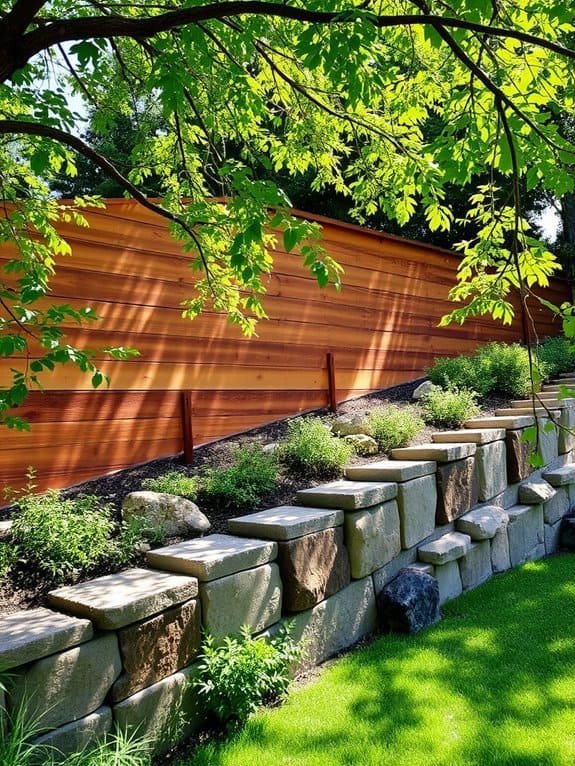
Natural stone accents can elevate your wood retaining wall into a striking centerpiece in your sloped backyard. The blend of rugged stones with smooth wood creates a captivating visual. Beyond aesthetics, these stones enhance the wall's structure and stability.
Here's a quick summary of popular natural stone options:
| Stone Type | Pros | Cons |
|---|---|---|
| Fieldstone | Rustic charm, unique shapes | Can be expensive |
| Slate | Sleek, modern appearance | Heavy and challenging to handle |
| River Rock | Smooth texture, natural look | Requires more maintenance |
Incorporating these stones not only boosts aesthetic appeal but also adds character. Feel free to mix and match or create patterns that reflect your style. Embrace nature in your backyard! Your wood retaining wall will appreciate the upgrade, and your neighbors may envy your design!
Garden Path Integration
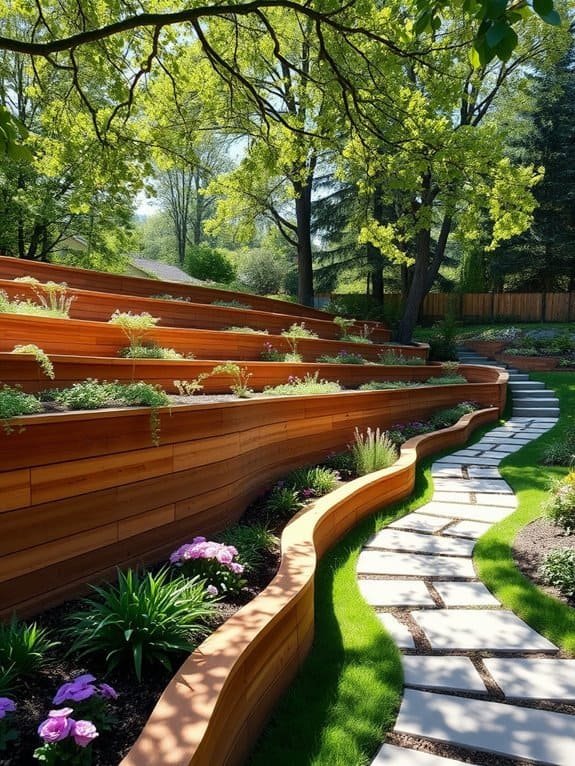
Integrating a garden path with your wood retaining wall enhances both functionality and beauty, creating a seamless transition in your landscape.
Picture yourself strolling through your backyard, enjoying a pathway that connects different areas effortlessly, almost like a personal tour guide for your garden!
To make your garden path stand out, consider these three tips:
- Material Match: Use materials for your path that match your wall, like wooden planks or gravel, to create a cohesive look.
- Curvy Designs: Choose gentle curves over a straight path for added visual interest and a more inviting feel.
- Plant Integration: Line your path with plants to soften the appearance and add color, but ensure they don't encroach on your walking space to avoid trips.
With these suggestions, you can create a stunning garden path that beautifully complements your wood retaining wall, transforming your sloped backyard into an inviting retreat.
Multi-Level Terracing
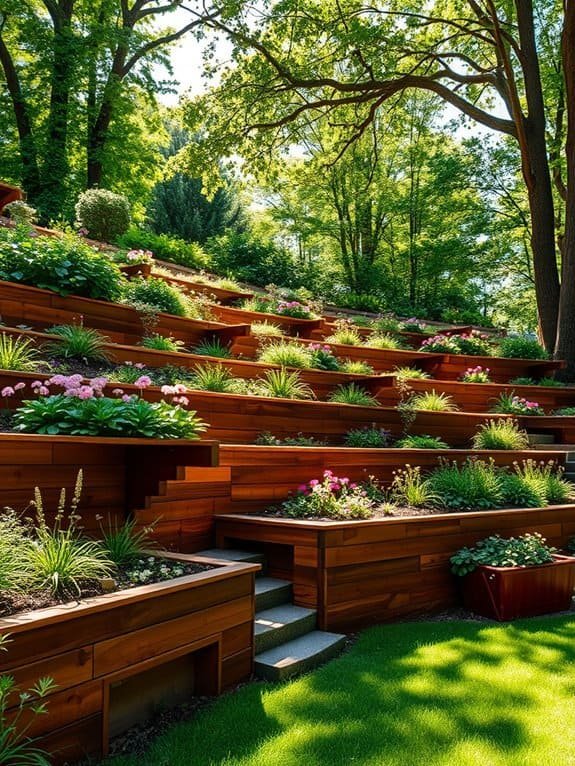
Creating multi-level terracing in your sloped backyard maximizes usable space and enhances landscape depth.
Picture stepping into a yard with inviting levels designated for various purposes, like a cozy lounging area, a vibrant flower garden, or a mini vegetable patch.
Building terraced areas with wood retaining walls adds rustic charm while preventing soil erosion.
Each level can be designed to optimize sunlight or provide afternoon shade, offering plenty of fun during the planning process.
Consider adding playful elements, like a winding path or unique seating.
With creativity and effort, your sloped backyard can transform into a stunning, functional multi-level retreat that's a pleasure to enjoy!
Stained Wood Finishes
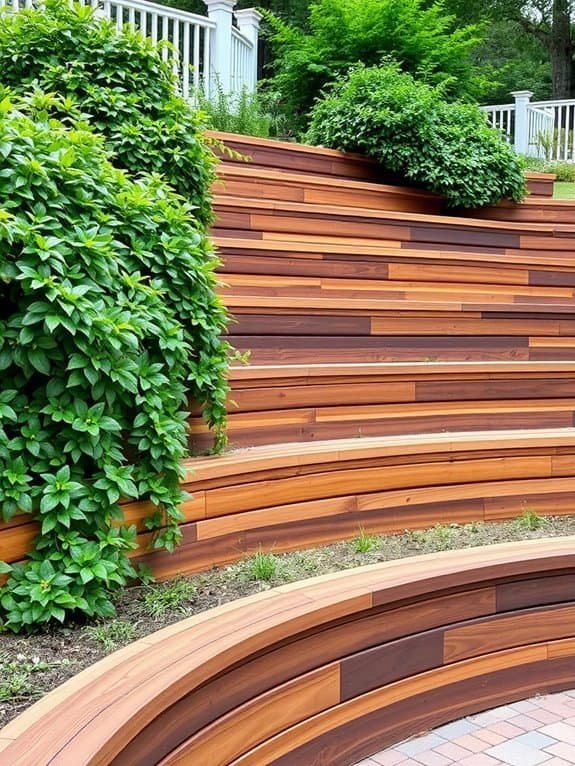
A beautiful stained wood finish enhances your retaining wall's appearance and offers protection against the elements.
Choosing a stain means you're not only selecting a color but also accentuating the wood's natural beauty and ensuring its durability. It's a win-win!
Here are three benefits of a stained finish:
- Weather Resistance: Stains provide a barrier against moisture and UV rays, ensuring your wall remains beautiful for years, eliminating issues like peeling paint.
- Aesthetic Appeal: With various shades available—from rich mahogany to subtle oak—a stain can complement your backyard's style, making it a standout feature.
- Easy Maintenance: Stained wood requires less upkeep than painted surfaces; a simple wash occasionally keeps your wall looking fresh.
Frequently Asked Questions
What Is the Best Wood Type for Retaining Walls?
When choosing the best wood for retaining walls, you can't go wrong with pressure-treated pine. It's durable, affordable, and resistant to rot!
Cedar's another great option; it's naturally resistant to insects and decay, plus it smells fantastic!
Just remember, whatever wood you pick, you'll want to treat it to extend its life.
How Deep Should the Foundation Be for a Wood Retaining Wall?
When you're building a wood retaining wall, you'll want your foundation to be sturdy.
Typically, a depth of about 2 feet is recommended—this helps prevent any wobbling or leaning. If your soil's pretty loose, you might even dig deeper to give it extra support.
Do I Need a Permit for Building a Retaining Wall?
You might need a permit for building a retaining wall, but it really depends on your local regulations.
Some places have strict rules, while others are pretty laid-back. It's always best to check with your local zoning office before you start digging.
You wouldn't want to get in trouble for something as simple as a wall, right? Plus, getting a permit could save you from headaches later on.
Happy building!
How Can I Prevent Wood Rot in My Retaining Wall?
To prevent wood rot in your retaining wall, you've gotta start with pressure-treated wood, which resists moisture.
Adding a waterproof sealant is a game-changer, too!
Make sure your drainage is excellent, so water doesn't pool around the base.
And don't forget to keep plants and soil away from the wood; they can hold moisture like a sponge.
With these tips, your wall will stand tall, and rot won't stand a chance!
What Is the Average Lifespan of a Wood Retaining Wall?
Picture your beautiful backyard, with a charming wood retaining wall holding everything together.
On average, a wood retaining wall lasts about 15 to 20 years, depending on factors like climate, maintenance, and wood type.
If you treat it well, it can be the sturdy friend you never knew you needed!
Just think of it as a wooden guardian, standing tall through rain and shine.
With a little love, it'll keep your yard stylish for years!
Conclusion
Ready to transform your sloped backyard into a stunning oasis? With options like tiered planter boxes and curved walls, your outdoor space can truly shine.
Imagine sipping coffee on a built-in seat, surrounded by vibrant greenery! The possibilities are endless, and you don't need to be a design expert to make it happen.
Embrace your creativity and let your backyard reflect your style. Before you know it, you'll have the envy of the neighborhood!

